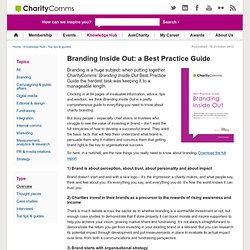

A resource for telling stories about international development and humanitarian issues. A resource for telling stories about international development and humanitarian issues. How NGOs can use Social Media. More than Publicity: Promoting NGOs in Social Media. How Other Companies can Benefit from Successful NGO Campaigns Non-governmental organizations (NGOs) and charity groups may be different from businesses in their core level, but the two groups are the same when it comes to social media.

Their social media goals are no different from each other. Both of them seek to connect with their target audience through social networking pages in Facebook and Twitter. It is more important, though, for NGOs to engage more with their followers. This is because they have limited resources which could not be touched often to finance publicity campaigns like other profitable groups do. More and more people are now going online and joining social networks. How do NGOs catch the attention of the online world and get support for their causes? 1. There are many types of content that circulates around the web: status videos, photos, videos and links. This impresses upon the need for NGOs to post more photos and videos, as both get the highest engagement rates.
Branding Inside Out: a Best Practice Guide. Branding is a huge subject: when putting together CharityComms’ Branding Inside Out Best Practice Guide the hardest task was keeping it to a manageable length.

Clocking in at 84 pages of invaluable information, advice, tips and wisdom, we think Branding Inside Out is a pretty comprehensive guide to everything you need to know about charity branding. But busy people – especially chief execs or trustees who struggle to see the value of investing in brand – don’t want the full intricacies of how to develop a successful brand. They want the basic facts that will help them understand what brand is, persuade them why it matters and convince them that getting brand right is the key to organisational success. So here, in a nutshell, are the nine things you really need to know about branding. Download the full report. 1) Brand is about perception, about trust, about personality and about impact 2) Charities invest in their brands as a precursor to the rewards of rising awareness and income. Mmercial-style branding does not work for charities.
Commercial-style branding can do bad things to your charity, says Jeff Brooks.

“Our fundraising results have dropped since we put our new brand standards in place, but that’s OK because the new brand so brilliantly articulates who we are as an organisation.” – Charity marketing director. Don’t laugh. I’ve heard this statement and others like it many times. It points out the bankruptcy that lies at the heart of so many charity branding efforts.
According to some, communication standards that hurt fundraising effectiveness but make people inside the organisation feel good are perfectly fine. Almost every time a charity goes through a rebranding and creates a commercial-style brand for itself, fundraising revenue falls. Why would a discipline that’s specifically designed to make companies more distinct, likeable, memorable, and sales-worthy wreak so much damage in the charity world? NGO Communications. The Smallest Nonprofits Should Have The Most Powerful Brands. (Product) Red.

Campaigns: NGOs get handy with stick and carrot. Creative Advertisements for NGO. Why Can't We Sell Charity Like We Sell Perfume? The early Puritan settlers in the New World were pulled in opposite directions by competing value systems.

They were extremely aggressive capitalists, but they were also strict Calvinists, taught that self-interest was a sure path to eternal damnation. How could they negotiate this psychological tension? Charity became a big part of the answer—an economic sanctuary in which they could do penance for their profit-making tendencies, at five cents on the dollar. Today, Americans are the world's most generous contributors to philanthropic causes. Each year, we give about 2% of our GDP to nonprofit organizations, nearly twice as much as the U.K., the next closest nation, according to the Chronicle of Philanthropy. Yet we cling to a puritan approach to how those donations are spent: Self-deprivation is our strategy for social change. The Role of Brand in the Nonprofit Sector. Many nonprofits continue to use their brands primarily as a fundraising tool, but a growing number of nonprofits are developing a broader and more strategic approach, managing their brands to create greater social impact and tighter organizational cohesion.

Nonprofit brands are visible everywhere. Amnesty International, Habitat for Humanity, and World Wildlife Fund are some of the most widely recognized brands in the world, more trusted by the public than the best-known for-profit brands.1 Large nonprofits, such as the American Cancer Society and the American Red Cross, have detailed policies to manage the use of their names and logos, and even small nonprofits frequently experiment with putting their names on coffee cups, pens, and T-shirts. Branding in the nonprofit sector appears to be at an inflection point in its development. The Bill & Melinda Gates Foundation, for example, recently appointed Tom Scott as director of global brand and innovation. “We’re catalysts,” says Scott.